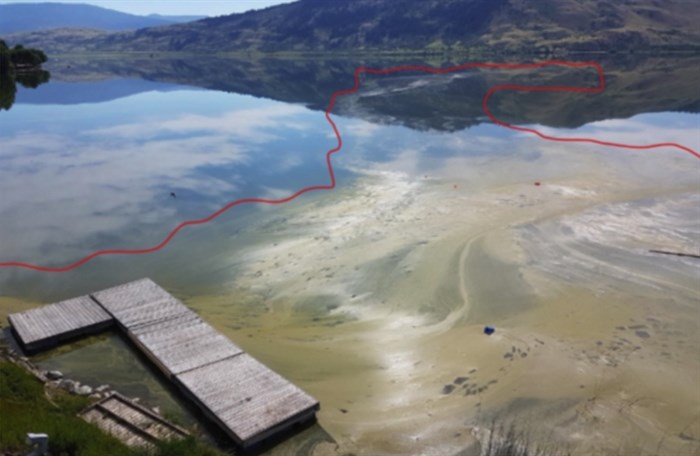
An image of the green-brown substance discovered inOkanagan Lake June 25, 2017.
Image Credit: SUBMITTED/Okanagan Indian Band
June 27, 2017 - 4:42 PM
VERNON - A possible algae bloom at the north end of Okanagan Lake continues to be monitored and the Ministry of Environment says there is no evidence that raw sewage made it into the water.
The incident was first reported over the weekend by the Okanagan Indian Band as a discharge of raw sewage into the lake. After an assessment, it was determined that the substance was in fact an algae bloom caused by increased nutrients (sewage, grass, leaves, and dead animals) and high temperatures.
An information officer for the Okanagan Indian Band could not be reached by phone Monday, June 26 or Tuesday, June 27 but said by text message the algae bloom is a natural occurrence caused by flooding and continues to be monitored. The officer did not provide the exact location of the algae bloom.
The First Nations Health Authority did not provide an interview but confirmed by email that it has been in contact with the Emergency Operations Centre director for the Okanagan Indian Band and Interior Health about the issue.
“Details on the species, size and extent of the bloom are unclear at present. The First Nations Health Authority has committed to doing cyanobacteria testing, per provincial and national guidelines, to identify any risk to human health from recreational or drinking water exposure,” the statement says.
Initially, the Ministry of Environment said the incident was under the jurisdiction of the Okanagan Indian Band and First Nations Health Authority, and suggested contacting them. Following a series of follow up questions, the ministry provided a written response. In it, the ministry says it was notified of increased algal growth and debris in Okanagan Lake by the local First Nation.
“There is no confirmation that this is actually a bloom,” the province said.
According to the ministry, some of the debris materials may have been washed into the lake during recent high water.
“As well, some of the flooded low lying area on the Indian Reserve land have septic disposal fields, although the ministry is not aware of evidence that untreated sewage has escaped these systems and entered surface water,” the ministry states.
The ministry confirmed there have been no bypasses of sewage treatment plants during the flooding and high water events in Okanagan Lake.
“All sewage effluent that has been discharged to the lake is treated,” the ministry said.
According to the province, there have been a number of algal bloom complaints already this year in various parts of the province and staff are following up “where appropriate, providing advice to local health authorities if necessary when those blooms have the potential to create toxins as a result of the specific species present.”
“In some instances complaints about blooms have actually been pollen deposited on the lake surface,” the ministry said.
Algae blooms are a common natural phenomenon that occur in lakes during higher temperatures such as in late summer and early autumn, the ministry said.
“Blooms are occurring earlier in the season and lasting longer, likely due to milder winters, and warmer springs,” it says.
The First Nations Health Authority said in a written statement it has been conducting recreational water sampling along the lake for E. coli and total coliforms and will continue to do so, in coordination with the Okanagan Indian Band. Due to the physical hazards present from the flooding, the health authority is encouraging people to use extreme caution when recreating in that area of the lake.
In an information bulletin posted June 26 to its Facebook page, the Okanagan Indian Band advises that if you spot an algae bloom, assume toxins are present, avoid contact with it and consumption of the water, and do not let pets or livestock come into contact with it.
To contact a reporter for this story, email Charlotte Helston or call 250-309-5230 or email the editor. You can also submit photos, videos or news tips to the newsroom and be entered to win a monthly prize draw.
We welcome your comments and opinions on our stories but play nice. We won't censor or delete comments unless they contain off-topic statements or links, unnecessary vulgarity, false facts, spam or obviously fake profiles. If you have any concerns about what you see in comments, email the editor in the link above.
News from © iNFOnews, 2017